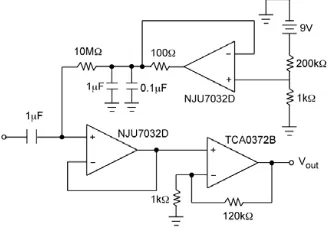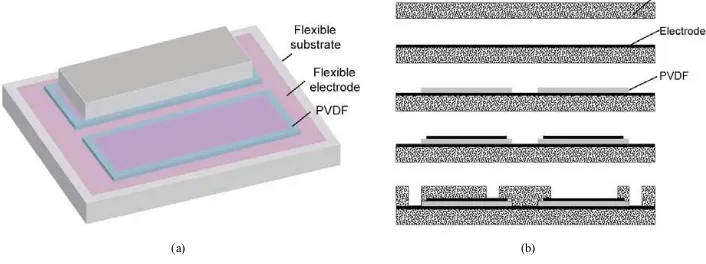Procedia Engineering 00 (2009) 000–000
Procedia
Engineering
www.elsevier.com/locate/procedia
Proc. Eurosensors XXIV, September 5-8, 2010, Linz, Austria
A PVDF-based Flexible Cardiorespiratory Sensor with
Independently Optimized Sensitivity to Heartbeat and Respiration
Yongang Jiang
a*, Hiroyuki Hamada
a, Syohei Shiono
b, Kensuke Kanda
a,b,
Takayuki Fujita
a,b, Kohei Higuchi
a, Kazusuke Maenaka
a,ba
Maenaka Human-Sensing Fusion Project, Japan Science and Technology Agency, Shosha, Himeji, Japan
b
Department of Electrical Engineering and Computer Sciences, Graduate School of Engineering, University of Hyogo, Shosha, Himeji, Japan
Abstract
Monitoring of cardiorespiratory information such as the respiration and heartbeat is very important for public healthcare. Belt-type cardiorespiratory sensors using polyvinylidene fluoride (PVDF) as the sensing material have been studied by many research groups. In order to extract the respiration and heartbeat signals from the sensor output, very complicated low-frequency filtering circuits and analysis schemes are required. In this research, we propose a PVDF-based cardiorespiratory sensor with independently optimized sensitivity to heartbeat and respiration. The sensor comprises of a sensitive unit and a bending-insensitive unit. The heartbeat signal can be optimized by using the bending-bending-insensitive mode, and the respiration signal can be maximized by using the bending sensitive mode. This principle was experimentally verified using a prototype device. A batch fabrication process for the patch-type cardiorespiratory sensor made of flexible substrate, PVDF and flexible electrode was described.
© 2009 Published by Elsevier Ltd.
Keywords:PVDF; cardiorespiratory sensor; respiration; heartbeat rate;
1. Introduction
The increase in population ageing and lifestyle diseases has stimulated greater interest in issues of safety, welfare and health care. The conventional medical care in hospital is inconvenient for patients who cannot afford the high medical expenses or live far away from the hospitals. In addition, the in-hospital examination are insufficient for the doctors to give correct prescriptions to the patients with lifestyle diseases such as melancholia or dying from overwork caused by the modern life, which is full of expectations and depressions. As a result, the field of sensor systems for automated healthcare monitoring at home is growing rapidly. Wearable sensor systems for monitoring our physical condition and our immediate environment can greatly contribute to in-home healthcare and preventive medicine [1]. On the other hand, cardiorespiratory signs, such as heartbeat and respiratory cycles, are kinds of the
health indicators for estimation of person’s health condition, which needs a long-term monitoring activity. However, most of developed devices are belt-type and useful just in case that the human body doesn’t move [2-5]. The purpose of this research is to develop a polyvinylidene fluoride (PVDF) based patch-type cardiorespiratory sensor device for long-term and unconscious monitoring of person’s cardiorespiratory signs. As both the heartbeat rate (40 to 80 beats per minute) and the respiration rate (12 to 20 breaths per minute) are very low, complicated filtering circuits and analysis schemes are required for conventional piezoelectric cardiorespiratory sensors [6]. It is important to reduce the complexity of the electrical circuits and the power consumption of the total system, which can be realized by using an integrated sensor with a high sensitivity to both respiration and heartbeat. In this paper, a PVDF based cardiorespiratory sensor with independently optimized sensitivity to the respiration and heartbeat signals is proposed.
2. Principle and schematic structure of the sensor
The PVDF film is a piezoelectric polymer with very high piezoelectric voltage coefficient, which is very sensitive to the applied strain [7]. The patch-type cardiorespiratory sensor is composed of a PVDF film with sputtered NiCu electrodes on both sides of the film and a flexible substrate such as polydimethylsiloxane (PDMS). The sensor is an integration of a bending-insensitive structure (Fig. 1(a)), in which the PVDF film is sandwiched by two thin flexible substrates with an identical thickness, and a bending-sensitive structure (Fig. 1(b)), in which the PVDF film is located on the top of the substrate. The bending-insensitive structure is supposed to be sensitive to the heartbeat and insensitive to the respiration, whilst the bending-sensitive structure is optimized for respiration detection. The schematic structure of the novel cardiorespiratory sensor and the block diagram of the measurement method are shown in Fig. 2. The output from the sensor units for heartbeat and respiration detection are amplified and filtered, respectively. The cardiorespiratory signals are acquired by a microcontroller through an A/D converter. The microcontroller is used for data analysis, data storage, and data preparation for wireless communication.
(a) (b)
Fig. 1. Schematic structures of various types of PVDF based sensors: (a) bending-insensitive type, and (b) bending-sensitive type.
Fig. 2. Schematic structure of the novel cardiorespiratory sensor and block diagram of the total sensor system.
3. Experiments and Discussions
The fabrication result is illustrated in Fig. 3. PDMS is used as the flexible substrate with a thickness of 2 mm. For the sensing units, PVDF films with a thickness of 28 4m, a length of 30 mm and a width of 12 mm are utilized. The inner capacitances of the sensing units are both approximately 1.3 nF. Using a simple voltage amplification circuit as shown in Fig. 4, the detection of the heartbeat and respiration is performed. The output of the cardiorespiratory sensor is connected to a buffer circuit to transfer the high impedance of the sensor to low impedance, and then amplified using an amplification circuit with a gain of 120. A bias is applied offset voltage output for the following A/D conversion. For the bending-sensitive unit, the heartbeat signals are clearly detected when the person is with suppressed respiration. When the person is with normal respiration, the respiration signal become so large that the heartbeat signal couldn’t be seen clearly as shown in Fig. 5(a). However, for bending-insensitive type device, the respiration signal is smaller than the heartbeat signal when the person is with normal respiration as shown in Fig. 5(b). As a result, the sensitivity of the sensor to heartbeat and respiration can be determined independently by using a specific type of structure and optimized dimensions of the substrate.
Fig. 3. Fabricated PVDF-based cardiorespiratory sensor. Fig. 4. Measurement circuit for the PVDF based sensors.
(a) (b)
Fig. 5. (a) Cardiorespiratory detection results using the bending-sensitive mode PVDF sensor shown in Fig.1 (b), which is attached to the chest, when the person is with normal respiration and with suppressed respiration, respectively. (b) Cardiorespiratory detection results using the bending-insensitive mode PVDF sensor shown in Fig.1 (a), when the person is with normal respiration and with suppressed respiration, respectively.
In order to improve the productivity of the cardiorespiratory sensor, a novel device which is applicable to batch fabrication is proposed as shown in Fig. 6(a). This device can be fabricated using a process as shown in Fig. 6(b). The flexible substrates are patterned by a molding method, and the flexible electrodes are formed using an inkjet-printing technique. PVDF films are deposited using an ionized evaporation technique. The realization of batch fabrication can greatly reduce the fabrication cost, which is important for the disposable sensors for health monitoring application.
(a) (b)
Fig. 6. (a) Schematic structure of cardiorespiratory sensor which can be batch fabricated; (b) Batch fabrication process for the cardiorespiratory sensor using PDMS, evaporated PVDF, and flexible electrodes.
4. Conclusions
In this paper, a cardiorespiratory sensor using PVDF and flexible substrates for human health monitoring application was described in details. By integration of a bending-sensitive unit and a bending insensitive unit with a flexible substrate, a cardiorespiratory sensor with an independently optimized sensitivity to respiration and heartbeat was developed. The principle of the cardiorespiratory sensor was experimentally demonstrated using a prototype device. In addition, a batch fabrication process was proposed for the future PVDF-based cardiorespiratory sensor to improve the productivity and reduce the production cost.
References
[1] Jones V, Gay V and Leijdekkers P. Body sensor networks for mobile health monitoring: experience in Europe and Australia, ICDS 2010; February 10-16, 2010, Netherlands Antilles.
[2] Adnane M, Jiang Z, Choi S and Jang H. Detecting specific health-related events using an integrated sensor system for vital sign monitoring,
Sensors 2009;9:6897-6912.
[3] Siivola, J, Heino J, Leinonen K and Moilanen K. The recording of respiration with PVDF-polymer detector in premature babies suffering from breathing disorders, Pediatric Research 1999;45(5):16A.
[4] Kim KJ, Chang YM, Yoon S and Kim HJ. A novel piezoelectric PVDF film-based physiological sensing belt for a complementary respiration and heartbeat monitoring system, Integrated Ferroelectrics 2009;107:53-68.
[5] Choi S and Jiang Z. A novel wearable sensor device with conductive fabric and PVDF film for monitoring cardiorespiratory signals,Sensors and Actuators 2006;A128:317-326.
[6] Wang F, Tanaka M and Chonan S. Development of a PVDF piezopolymer sensor for unconstrained in-sleep cardiorespiratory monitoring,
Journal of Intelligent Material Systems and Structures 2003;14:185-190.
[7] Chen Y, Wang L and Ko WH. A piezopolymer finger pulse and breathing wave sensor, Sensors and Actuators 1990;A21-23:879–882.


